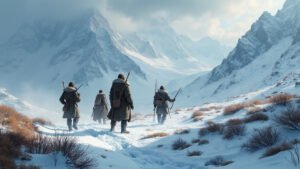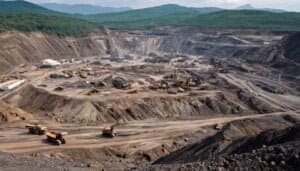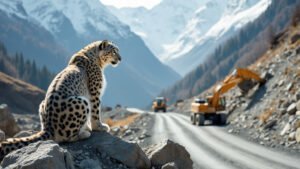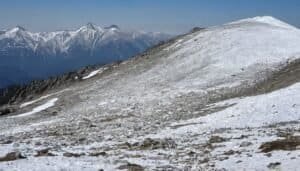Introduction
Snow leopards, the elusive big cats of the high mountains, face numerous threats that jeopardize their survival. This article delves into the primary dangers snow leopards encounter, including poaching, habitat loss, climate change, and conflicts with livestock herders
We will explore how these factors impact snow leopard populations, examine the role of illegal wildlife trade, and discuss ongoing conservation efforts aimed at safeguarding these magnificent creatures
Through understanding these threats, we can better appreciate the urgency of protecting snow leopards and their fragile ecosystems
The Impact of Poaching on Snow Leopard Populations
Poaching remains one of the most significant threats to snow leopard populations. Driven by demand for their fur and bones, poachers target these majestic creatures, severely impacting their numbers
This section explores the poaching practices, the scale of the problem, and international efforts to combat this illegal activity
Poaching Practices and Motives
Poaching of snow leopards is primarily driven by the lucrative illegal wildlife trade. Snow leopard pelts are highly valued in the black market, where they are sold as luxury items
Additionally, their bones are sought after for traditional Asian medicine, believed to possess various health benefits. Despite international bans on trade in snow leopard parts, the high demand continues to fuel poaching activities
Poachers often use steel traps, snares, and guns to capture or kill snow leopards. These methods are not only cruel but also indiscriminate, often injuring or killing non-target species. The remoteness of snow leopard habitats makes enforcement challenging, allowing poachers to operate with relative impunity
The Scale of Poaching Incidents
Quantifying the exact number of snow leopards poached annually is difficult due to the clandestine nature of the activity
However, conservation organizations estimate that several hundred snow leopards are killed each year. This figure represents a significant portion of the estimated global population of 4,000 to 6,500 individuals
In some regions, poaching has led to alarming declines in snow leopard populations. For instance, in certain parts of Central Asia, snow leopard numbers have plummeted due to persistent poaching pressure
The loss of even a few individuals can have cascading effects on local populations, given the species’ low reproductive rate and the vast territories each individual requires
International Efforts to Combat Poaching
Recognizing the urgent need to address poaching, various international agreements and organizations have been established to protect snow leopards
The Convention on International Trade in Endangered Species of Wild Fauna and Flora (CITES) lists snow leopards in Appendix I, which prohibits international trade in snow leopard parts except under exceptional circumstances
The Global Snow Leopard and Ecosystem Protection Program (GSLEP), launched in 2013, is a collaborative initiative involving 12 snow leopard range countries. GSLEP aims to secure 20 snow leopard landscapes by 2020 through a combination of anti-poaching measures, community engagement, and habitat protection
In addition to international agreements, numerous non-governmental organizations (NGOs) are actively working to combat poaching. The Snow Leopard Trust, for example, conducts anti-poaching patrols, educates local communities, and supports sustainable livelihoods to reduce reliance on poaching
Similarly, Panthera’s Snow Leopard Program focuses on improving law enforcement, reducing human-wildlife conflict, and monitoring snow leopard populations
Habitat Loss and Its Effects on Snow Leopards
Habitat loss is a pressing issue for snow leopards, as their mountainous homes are increasingly encroached upon by human activities. This section examines the causes of habitat loss, the fragmentation of snow leopard habitats, and efforts to restore and protect these critical areas
Causes of Habitat Loss
The primary drivers of habitat loss for snow leopards are human development and land use changes
Infrastructure projects such as roads, mining operations, and hydroelectric dams disrupt and degrade snow leopard habitats. These projects often involve deforestation and land clearance, reducing the availability of prey and suitable living areas for snow leopards
Agricultural expansion is another significant factor. As human populations grow, the demand for arable land increases, leading to the conversion of natural habitats into farmland. This encroachment not only reduces the space available for snow leopards but also brings them into closer contact with humans, heightening the risk of conflict and poaching
Fragmentation of Snow Leopard Habitats
Habitat fragmentation occurs when large, continuous habitats are broken into smaller, isolated patches
This fragmentation is particularly detrimental to snow leopards, which require vast territories to roam and hunt. Fragmented habitats limit their ability to find food, mate, and establish territories, leading to population declines
Fragmented habitats also isolate snow leopard populations, reducing genetic diversity and increasing the risk of inbreeding. This genetic bottleneck can make populations more vulnerable to diseases and environmental changes, further jeopardizing their survival
Additionally, isolated populations may face difficulties in recolonizing areas where snow leopards have been extirpated
Restoration and Protection of Habitats
Efforts to restore and protect snow leopard habitats are crucial for their long-term conservation. Several strategies are employed to address habitat loss and fragmentation, including:
Protected Areas: Establishing and expanding protected areas such as national parks and wildlife reserves is essential. These areas provide safe havens for snow leopards and other wildlife, ensuring they have the space and resources needed to thrive. Effective management of these areas involves preventing illegal activities like poaching and logging, as well as promoting sustainable tourism practices
Wildlife Corridors: Creating wildlife corridors that connect fragmented habitats allows snow leopards to move freely between different areas. These corridors facilitate gene flow and enable individuals to access larger territories, improving their chances of survival. Implementing corridors involves land-use planning and collaboration with local communities to minimize human-wildlife conflicts
Reforestation and Habitat Restoration: Reforestation projects aim to restore degraded areas by planting native vegetation and rehabilitating ecosystems. Restoring natural habitats improves prey availability and provides shelter for snow leopards. Community involvement in these projects is vital, as local people can play a significant role in maintaining and protecting restored areas
Sustainable Land-Use Practices: Promoting sustainable land-use practices among local communities helps reduce habitat destruction. This includes encouraging agroforestry, where trees are integrated into agricultural landscapes, and implementing practices that minimize soil erosion and degradation. By adopting sustainable methods, communities can meet their needs without compromising snow leopard habitats
Climate Change and Its Influence on Snow Leopards
Climate change is increasingly recognized as a critical threat to snow leopards, affecting their habitats and prey availability. This section explores how climate change impacts snow leopard habitats, alters prey dynamics, and examines the species’ potential for adaptation and resilience
Changes in Snow Leopard Habitats
Climate change is causing significant shifts in the high-altitude environments that snow leopards call home
Rising temperatures are leading to the retreat of glaciers and the reduction of snow cover, which in turn affects the availability of water sources and the overall structure of the habitat. As snow lines move higher, suitable habitats for snow leopards shrink, pushing them into smaller and more fragmented areas
Additionally, climate change is altering the composition of plant communities in these mountainous regions. Changes in vegetation can affect the distribution and abundance of prey species, such as the blue sheep and ibex, which are crucial for snow leopard survival. With prey populations potentially moving to higher altitudes or declining in number, snow leopards may face increased competition and food scarcity
Effects on Prey Availability
The impact of climate change on prey species is a major concern for snow leopard conservation. As temperatures rise, the distribution of herbivores like blue sheep and ibex is expected to change, potentially leading to mismatches between snow leopards and their prey
For example, if prey species move to higher altitudes in search of cooler environments, snow leopards will need to follow, leading to increased energy expenditure and stress
Moreover, the altered timing of plant growth and availability can affect the nutritional quality of forage for prey species. Poor nutrition can lead to reduced reproductive success and lower survival rates among prey populations, which directly impacts snow leopard food resources
A decline in prey availability can force snow leopards to hunt livestock, escalating human-wildlife conflicts and increasing the risk of retaliatory killings
Adaptation and Resilience of Snow Leopards
Despite the challenges posed by climate change, snow leopards exhibit some degree of adaptability and resilience. Their wide-ranging behavior and ability to traverse rugged terrain allow them to exploit various habitats and prey sources
However, their long-term survival will depend on the extent and pace of climate-induced changes and the effectiveness of conservation efforts
Research indicates that snow leopards may adjust their behavior and movement patterns in response to changing environmental conditions. For instance, they might alter their hunting strategies or expand their range to find suitable habitats and prey. Conservation programs that enhance habitat connectivity and protect diverse ecosystems can support these adaptive behaviors
Conservation Strategies to Mitigate Climate Change Impacts
To mitigate the effects of climate change on snow leopards, several conservation strategies are being implemented:
Monitoring and Research: Continuous monitoring of snow leopard populations and their habitats is essential to understand the impacts of climate change. Research efforts focus on tracking snow leopard movements, studying prey dynamics, and assessing habitat changes to inform adaptive management strategies
Habitat Protection and Restoration: Protecting high-altitude ecosystems and restoring degraded areas help maintain resilient habitats for snow leopards and their prey. Conservationists work to establish protected areas, promote sustainable land-use practices, and implement reforestation projects to enhance habitat quality and connectivity
Community Engagement: Engaging local communities in conservation efforts is crucial for addressing climate change impacts. Community-based initiatives that promote sustainable livelihoods, reduce dependence on natural resources, and increase awareness of climate change can foster local support for snow leopard conservation
Climate Change Mitigation: Efforts to mitigate climate change at a global scale, such as reducing greenhouse gas emissions and promoting renewable energy, are vital for the long-term survival of snow leopards. Conservation organizations advocate for climate action and collaborate with governments and international bodies to address the root causes of climate change
Human-Wildlife Conflict: Snow Leopards and Livestock Herders
Human-wildlife conflict is a significant issue affecting snow leopard populations, as these majestic cats often prey on livestock, leading to economic losses for herders. This section explores the nature of these conflicts, strategies to mitigate them, and examines successful examples and ongoing challenges
Nature of Conflicts
Snow leopards, primarily preying on wild ungulates, occasionally target livestock such as sheep, goats, and yaks when their natural prey is scarce or inaccessible. This behavior leads to considerable economic losses for local herders, who depend on livestock for their livelihoods
The loss of even a few animals can have a devastating impact on herder families, leading to resentment and retaliatory killings of snow leopards
The conflicts are exacerbated by the proximity of human settlements to snow leopard habitats. As human populations grow and expand into these regions, the frequency of encounters between snow leopards and livestock increases. Additionally, inadequate livestock management practices, such as poor corral construction, leave animals vulnerable to predation
Mitigation Strategies
Several strategies have been developed to mitigate human-wildlife conflict and promote coexistence between snow leopards and livestock herders:
Improved Livestock Management: Enhancing livestock management practices is crucial for reducing predation. Building predator-proof corrals, using guard dogs, and herding livestock during vulnerable times can significantly decrease livestock losses. Training and resources provided to herders can help them implement these measures effectively
Compensation Programs: Compensation schemes aim to offset the economic losses incurred by herders due to livestock predation. By providing financial compensation for lost animals, these programs reduce the motivation for retaliatory killings. However, the success of such programs depends on timely and fair compensation, as well as transparent and accessible processes for herders to report losses
Community-Based Conservation: Engaging local communities in conservation efforts fosters a sense of ownership and responsibility for protecting snow leopards. Initiatives like eco-tourism, handicraft production, and sustainable agriculture provide alternative income sources, reducing dependence on livestock and incentivizing conservation. Community-based monitoring programs also involve herders in tracking snow leopard movements and preventing conflicts
Livestock Insurance Schemes: Insurance schemes provide herders with financial security against livestock losses. By paying a small premium, herders receive compensation for animals lost to predation. These schemes encourage proactive measures to protect livestock and reduce the financial burden on herders, promoting coexistence
Education and Awareness: Raising awareness about snow leopard conservation and the importance of biodiversity helps change attitudes towards these predators. Educational programs in schools and communities emphasize the ecological role of snow leopards and the benefits of coexistence. Celebrating cultural and religious significance of snow leopards in local traditions also fosters positive perceptions
Success Stories and Challenges
Several success stories demonstrate the effectiveness of conflict mitigation strategies. For instance, the Snow Leopard Conservancy’s work in Ladakh, India, has led to significant reductions in livestock predation through improved corral construction and community-based tourism
Similarly, the Snow Leopard Trust’s community conservation programs in Mongolia and Kyrgyzstan have successfully engaged herders in monitoring and protecting snow leopards
However, challenges remain in scaling up these efforts and ensuring long-term sustainability. Funding limitations, bureaucratic hurdles, and varying levels of community engagement can hinder the effectiveness of mitigation programs. Additionally, the increasing impacts of climate change, such as altered prey dynamics and habitat degradation, add complexity to human-wildlife conflicts
Conservation Efforts to Protect Snow Leopards
Protecting snow leopards requires concerted conservation efforts involving governments, non-governmental organizations (NGOs), and local communities. This section discusses various initiatives, including government and NGO actions, community-based conservation programs, and future directions for preserving snow leopard populations
Government and NGO Initiatives
Governments in snow leopard range countries play a critical role in conservation through the establishment of policies, protected areas, and enforcement mechanisms. National laws and international agreements, such as CITES (Convention on International Trade in Endangered Species of Wild Fauna and Flora), provide a legal framework to protect snow leopards and their habitats
Key governmental initiatives include:
Protected Areas: Establishing national parks, wildlife reserves, and conservation areas to safeguard critical snow leopard habitats. Examples include India’s Hemis National Park and Mongolia’s Tost Tosonbumba Nature Reserve
Anti-Poaching Measures: Implementing anti-poaching patrols, intelligence networks, and stringent penalties to combat illegal hunting and trade of snow leopards
Research and Monitoring: Funding research programs to study snow leopard populations, genetics, and ecology, as well as monitoring efforts to track their distribution and movements
NGOs also play a vital role in snow leopard conservation by complementing government efforts and focusing on grassroots initiatives. Prominent organizations include the Snow Leopard Trust, Panthera, and the Snow Leopard Conservancy, which work on various fronts such as:
Community Engagement: Collaborating with local communities to promote coexistence, reduce human-wildlife conflicts, and develop alternative livelihoods
Education and Awareness: Conducting educational programs to raise awareness about snow leopard conservation among local populations and the broader public
Capacity Building: Providing training and resources to local conservationists, park rangers, and researchers to enhance their skills and effectiveness
Community-Based Conservation
Engaging local communities is crucial for the success of snow leopard conservation. Community-based approaches recognize the vital role that indigenous and local knowledge plays in protecting wildlife and habitats
Successful community-based conservation programs include:
Livestock Insurance Programs: As mentioned earlier, these programs compensate herders for livestock losses due to snow leopard predation, reducing retaliatory killings. For example, the Snow Leopard Trust’s livestock insurance program in Mongolia has been highly effective
Conservation Education: Initiatives that educate communities about the ecological and cultural importance of snow leopards foster positive attitudes and encourage protective behaviors. Schools and community centers often serve as platforms for these educational activities
Eco-Tourism: Developing eco-tourism ventures that provide economic benefits to local communities while promoting snow leopard conservation. These ventures include guided wildlife tours, homestays, and handicraft sales, which generate income and incentivize the protection of snow leopards and their habitats
Future Directions for Conservation
Future conservation efforts need to address emerging challenges and leverage new opportunities to enhance the protection of snow leopards. Key areas for future focus include:
Climate Change Adaptation: Developing strategies to help snow leopards and their prey adapt to changing environmental conditions. This includes habitat restoration, creating wildlife corridors, and ensuring water availability
Technological Advancements: Utilizing technology such as camera traps, GPS collars, and drones to monitor snow leopard populations and gather critical data for informed decision-making
Transboundary Cooperation: Promoting collaboration between neighboring countries to manage and protect snow leopard populations that traverse international borders. Initiatives like the Global Snow Leopard and Ecosystem Protection Program (GSLEP) facilitate such cooperation
Sustainable Development: Integrating snow leopard conservation into broader sustainable development agendas to ensure that economic growth does not come at the expense of biodiversity. This includes promoting sustainable land-use practices, reducing carbon footprints, and supporting green energy projects
Conclusion
The survival of snow leopards is under threat from multiple fronts, including poaching, habitat loss, climate change, and human-wildlife conflicts
Poaching driven by the illegal wildlife trade continues to decimate populations, while habitat loss and fragmentation further strain these elusive big cats. Climate change exacerbates these challenges by altering their habitats and prey availability, forcing snow leopards into closer contact with humans and livestock, leading to increased conflicts
Conservation efforts are critical in mitigating these threats. Governments, NGOs, and local communities are working together to establish protected areas, improve livestock management, and promote sustainable livelihoods
Education, awareness, and community-based conservation programs play a vital role in fostering coexistence and reducing retaliatory killings
Looking forward, addressing the impacts of climate change, leveraging technological advancements, promoting transboundary cooperation, and integrating conservation into sustainable development agendas will be essential for ensuring the long-term survival of snow leopards. Through these collaborative and adaptive strategies, we can protect these magnificent creatures and the fragile ecosystems they inhabit











